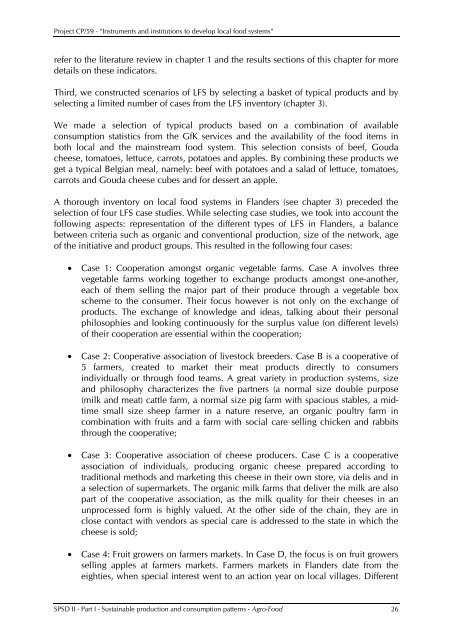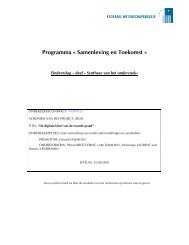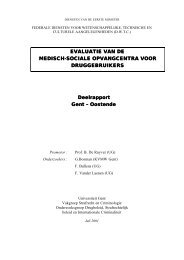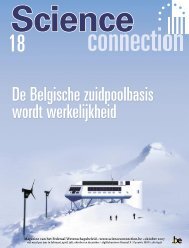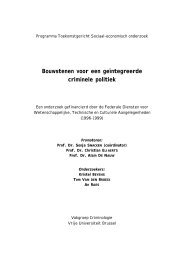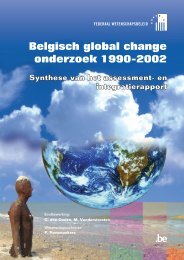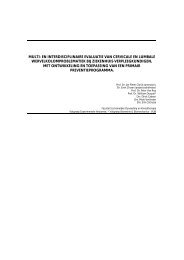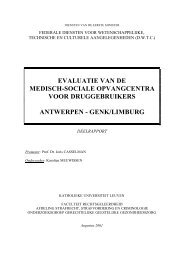chapter 3 inventory of local food systems
chapter 3 inventory of local food systems
chapter 3 inventory of local food systems
Create successful ePaper yourself
Turn your PDF publications into a flip-book with our unique Google optimized e-Paper software.
Project CP/59 - “Instruments and institutions to develop <strong>local</strong> <strong>food</strong> <strong>systems</strong>”<br />
refer to the literature review in <strong>chapter</strong> 1 and the results sections <strong>of</strong> this <strong>chapter</strong> for more<br />
details on these indicators.<br />
Third, we constructed scenarios <strong>of</strong> LFS by selecting a basket <strong>of</strong> typical products and by<br />
selecting a limited number <strong>of</strong> cases from the LFS <strong>inventory</strong> (<strong>chapter</strong> 3).<br />
We made a selection <strong>of</strong> typical products based on a combination <strong>of</strong> available<br />
consumption statistics from the GfK services and the availability <strong>of</strong> the <strong>food</strong> items in<br />
both <strong>local</strong> and the mainstream <strong>food</strong> system. This selection consists <strong>of</strong> beef, Gouda<br />
cheese, tomatoes, lettuce, carrots, potatoes and apples. By combining these products we<br />
get a typical Belgian meal, namely: beef with potatoes and a salad <strong>of</strong> lettuce, tomatoes,<br />
carrots and Gouda cheese cubes and for dessert an apple.<br />
A thorough <strong>inventory</strong> on <strong>local</strong> <strong>food</strong> <strong>systems</strong> in Flanders (see <strong>chapter</strong> 3) preceded the<br />
selection <strong>of</strong> four LFS case studies. While selecting case studies, we took into account the<br />
following aspects: representation <strong>of</strong> the different types <strong>of</strong> LFS in Flanders, a balance<br />
between criteria such as organic and conventional production, size <strong>of</strong> the network, age<br />
<strong>of</strong> the initiative and product groups. This resulted in the following four cases:<br />
• Case 1: Cooperation amongst organic vegetable farms. Case A involves three<br />
vegetable farms working together to exchange products amongst one-another,<br />
each <strong>of</strong> them selling the major part <strong>of</strong> their produce through a vegetable box<br />
scheme to the consumer. Their focus however is not only on the exchange <strong>of</strong><br />
products. The exchange <strong>of</strong> knowledge and ideas, talking about their personal<br />
philosophies and looking continuously for the surplus value (on different levels)<br />
<strong>of</strong> their cooperation are essential within the cooperation;<br />
• Case 2: Cooperative association <strong>of</strong> livestock breeders. Case B is a cooperative <strong>of</strong><br />
5 farmers, created to market their meat products directly to consumers<br />
individually or through <strong>food</strong> teams. A great variety in production <strong>systems</strong>, size<br />
and philosophy characterizes the five partners (a normal size double purpose<br />
(milk and meat) cattle farm, a normal size pig farm with spacious stables, a midtime<br />
small size sheep farmer in a nature reserve, an organic poultry farm in<br />
combination with fruits and a farm with social care selling chicken and rabbits<br />
through the cooperative;<br />
• Case 3: Cooperative association <strong>of</strong> cheese producers. Case C is a cooperative<br />
association <strong>of</strong> individuals, producing organic cheese prepared according to<br />
traditional methods and marketing this cheese in their own store, via delis and in<br />
a selection <strong>of</strong> supermarkets. The organic milk farms that deliver the milk are also<br />
part <strong>of</strong> the cooperative association, as the milk quality for their cheeses in an<br />
unprocessed form is highly valued. At the other side <strong>of</strong> the chain, they are in<br />
close contact with vendors as special care is addressed to the state in which the<br />
cheese is sold;<br />
• Case 4: Fruit growers on farmers markets. In Case D, the focus is on fruit growers<br />
selling apples at farmers markets. Farmers markets in Flanders date from the<br />
eighties, when special interest went to an action year on <strong>local</strong> villages. Different<br />
SPSD II - Part I - Sustainable production and consumption patterns - Agro-Food 26


